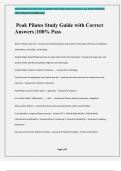EMILLYCHARLOTTE 2024/2025 ACADEMIC YAER ©2024 EMILLYCHARLOTTE. ALL RIGHTS RESERVED
FIRST PUBLISH SEPTEMBER 2024
Peak Pilates Study Guide with Correct
Answers |100% Pass
What is Pilates exercise? - Answer✔✔-teaches balance and control of the body; stretches, strengthens,
and balances the body; "contrology"
Joseph Pilates based Pilates exercise on what other forms of movement? - Answer✔✔-yoga, Zen, and
ancient Greek and Roman physical regimens and self-study
Joseph Pilates called his system of exercise -. - Answer✔✔-contrology
The first piece of equipment Joe created was the -; however, the first exercises he created were the -
exercises. - Answer✔✔-reformer, mat work
Peak Pilates teaches Pilates with a - approach. - Answer✔✔-classical
List 3 Peak Pilates "differences": -, -, and -. - Answer✔✔-fitness-based, systematic, integrated
Who are the 'Elders'? - Answer✔✔-those who learned directly under Joseph Pilates
List 8 benefits of regular Pilates exercise: - Answer✔✔-1. Whole Body Health 2. Whole Body
Commitment and Breath 3. Concentration 4. Centering 5. Control 6. Breathing 7. Precision 8. Flowing
Movement
Two parts of the Peak Pilates Principles - Answer✔✔-Pilates Principles + 5 Parts of the Mind
Page 1/42
,EMILLYCHARLOTTE 2024/2025 ACADEMIC YAER ©2024 EMILLYCHARLOTTE. ALL RIGHTS RESERVED
FIRST PUBLISH SEPTEMBER 2024
Pilates Principles: - Answer✔✔-Concentration, Centering, Control, Breathing, Precision, Flowing
Movement
5 Parts of the Mind: - Answer✔✔-Intelligence, Memory, Imagination, Intuition, Will/Desire
The PPC1 Session Format: - Answer✔✔-a. Mat (15-20 minutes) b. Reformer (20 minutes) c. Individual
Needs (10 minutes) d. Ending (5 minutes)
Parts - and - of the Session Format are interchangeable. - Answer✔✔-A, B
PPC1 Teaching Methodology: - Answer✔✔-Setup, Execution, Flow, Cueing, Rhythm, Voice, Breath
Dynamics
Presentation Skills: - Answer✔✔-Safety, Exercise Delivery, Teacher's Posture, Touch Techniques,
Professionalism, Teacher Mindfulness
Guidelines for Progression: - Answer✔✔-Adhere to session format, Introduce no more than one
variation or apparatus, Teach to the student's ideal, Build strength and stamina through steps, Teach
transitions as part of an exercise, Challenge the ideal with props, variations, rhythms, flow, and breath-
not with more reps
Pilates believed in beginning the lesson lying down because ---------. - Answer✔✔-gravity assists in the
elongation and spinal placement
Focus on thoroughly teaching the - exercises before moving a student on to more advanced exercises. -
Answer✔✔-basic
List 4 indicators of progressing a student too quickly: - Answer✔✔-loss of concentration, loss of
coordination, poor technique, pain following the session
Page 2/42
,EMILLYCHARLOTTE 2024/2025 ACADEMIC YAER ©2024 EMILLYCHARLOTTE. ALL RIGHTS RESERVED
FIRST PUBLISH SEPTEMBER 2024
A concept that describes how each exercise is stabilized by the Powerhouse and supported by critical
connections. - Answer✔✔-Anchoring
Stacking one vertebrae at a time, lifting bone by bone, or rolling down and releasing the vertebrae onto
the mat one vertebra at a time. - Answer✔✔-Articulate/Segment
Rectangle formed by 2 imaginary lines running from shoulder to shoulder and from hip to hip and
completed by 2 lines running from shoulder to hip. - Answer✔✔-Box
Simpler versions of an exercise; "stepping stone" - Answer✔✔-Building Blocks
Shape the spine and body assumed during many Pilates exercises. Created by deep pull of the transverse
abdominis wrapping around the spine and opening the spinal column in flexion. - Answer✔✔-C Curve
The line running downward from the nose, navel, and pubic bone to the heels - Answer✔✔-Centerline
A symptom or health condition that makes a particular exercise inadvisable or unsuitable for a student to
perform. - Answer✔✔-Contraindications
Connections that deepen the work in the Powerhouse and improve execution. 1. Three Anchors 2. Rib to
scapula/Scapula to rib 3. Heel and Buttock connection - Answer✔✔-Critical Connections
The action of elongating and creating space between the vertebrae - Answer✔✔-Decompression
A way to approach and cue rolling the spine segments: tailbone to top off pelvis, top of pelvis to base of
sternum/bottom of ribs, and bottom of ribs to skull - Answer✔✔-Dividing the Spine Into Thirds
Image of buttons pressing from front to back and back to front through the body.
Segments:
Page 3/42
, EMILLYCHARLOTTE 2024/2025 ACADEMIC YAER ©2024 EMILLYCHARLOTTE. ALL RIGHTS RESERVED
FIRST PUBLISH SEPTEMBER 2024
Lowest- Pubic Bone
Second- Sacral Level
Third- Navel
Fourth- Xiphoid Process
Fifth- Breastbone - Answer✔✔-Five Buttons
A reference point that describes the limit of healthy movement in Pilates. Outline of the body or
apparatus. Body frames movement. Apparatus frames body. - Answer✔✔-Frame
An image that invokes the feeling of power, strength, and stability created by the Pilates stance. -
Answer✔✔-The Greek Column
A term used to distinguish movements starting from the Powerhouse and center and flowing outward. -
Answer✔✔-Initiate
A movement quality of reaching an extremity without tensing it. Deepens work in powerhouse. -
Answer✔✔-Length
Adaptations to an exercise that are used for special cases. Accessible for health concerns. - Answer✔✔-
Modifications
Concept that every exercise has an anchor and a force reaching away from the anchor. - Answer✔✔-
Opposition
Active engagement of the buttocks muscles "pinch, lift, and grow tall as you sit" - Answer✔✔-Perch
Feet softly pointed, rather than being clenched strongly in plantar flexion. - Answer✔✔-Pilates Point
Page 4/42




